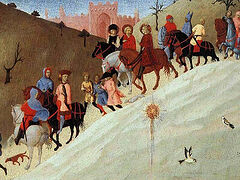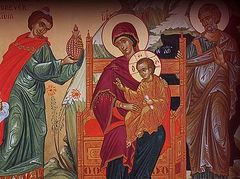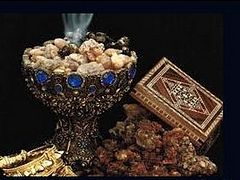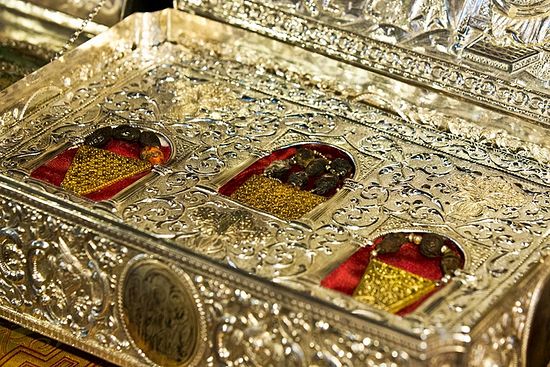 The Gifts of the Magi. Photo by Igor Belokopytov
The Gifts of the Magi. Photo by Igor Belokopytov
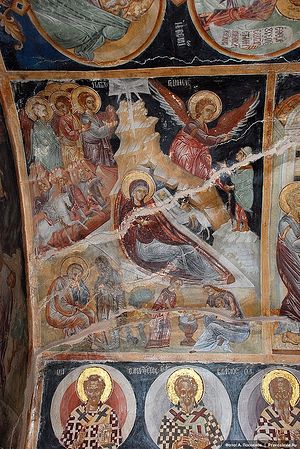 The Nativity of Christ. Fresco in the ancient Serbian church at St. Paul’s Monastery, Mt. Athos. Photo by Anton Pospelov / Pravoslavie.ru Now when Jesus was born in Bethlehem of Judaea in the days of Herod the king, behold, there came wise men from the east to Jerusalem, Saying, Where is He that is born King of the Jews? for we have seen His star in the east, and are come to worship Him (Mt. 2:1-2), St. Matthew the Evangelist relates.
The Nativity of Christ. Fresco in the ancient Serbian church at St. Paul’s Monastery, Mt. Athos. Photo by Anton Pospelov / Pravoslavie.ru Now when Jesus was born in Bethlehem of Judaea in the days of Herod the king, behold, there came wise men from the east to Jerusalem, Saying, Where is He that is born King of the Jews? for we have seen His star in the east, and are come to worship Him (Mt. 2:1-2), St. Matthew the Evangelist relates.
Six centuries before the Birth of Christ, during the Babylonian Captivity of the Jews, religious thinkers of the East first discovered the Bible and the ancient prophecy of the Star of Bethlehem, mentioned by the diviner Balaam who had predicted the coming of the Messiah: there shall come a Star out of Jacob, and a Sceptre shall rise out of Israel (Num. 24:17). It was then, during the Babylonian Captivity, that the Prophet Daniel predicted the exact date of the Birth of the Messiah (Dan. 9:25). Every Jewish household knew about it. King Herod was no exception. That is why the Magi’s questions about the Royal Infant frightened him so much. Herod called together the chief priests and scribes and found out that according to the Prophet Micah, the Messiah was to be born in Bethlehem (Mic. 5:2).
According to the Gospel, then Herod secretly invited the Magi to his palace and learned that the Star had appeared in the firmament before the Birth of the One they were looking for and it was precisely that Star that had led them on their journey. So he directed the Wise Men to the little town of Bethlehem to find the Infant so that he too might come and bow before Him. When the Magi left Jerusalem, the Star again lit their way and led them right to the house where the Theotokos with Her Son and Righteous Joseph the Betrothed were living: And when they were come into the house, they saw the young Child with Mary His Mother, and fell down, and worshipped Him (Mt. 2:11).
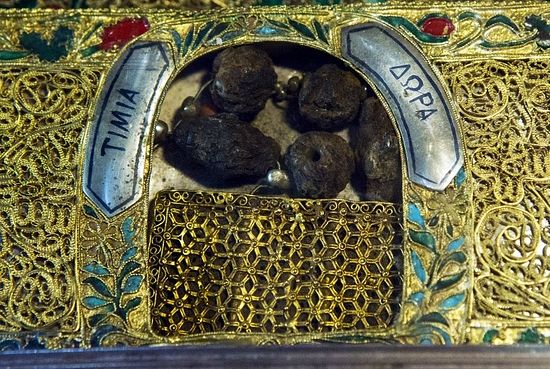 The Gifts of the Magi. Photo by Igor Belokopytov
The Gifts of the Magi. Photo by Igor Belokopytov
Who were the Magi that came to bow before the Infant Christ? This event became a subject of reflection for many commentators already in the earliest monuments of Christian literature. Following the New Testament tradition, Christianity from the very beginning had a negative attitude towards magic and astrology, regarding them as occupations incompatible with the concept of free will and the Providence of God about man. But Matthew the Evangelist speaks of the Magi in a positive sense, as of people doing a godly deed, in contrast to the Jews who did not accept the Savior. The pagan world accepted the Savior, whereas the chosen people failed to recognize its Lord and Creator. Speaking of the Wise Men, the Evangelist uses the term “μάγοι”—that is, ”magicians”, the Magi. There were two meanings of this term in ancient literature: firstly, people associated with Zoroastrian priests of Persia, and, secondly, Babylonian astrologer priests. It is impossible to say with certainty which country the wise astrologers came from: most likely they were from Persia or Babylonia. The messianic expectations of the Jews were known in these countries thanks to the Prophet Daniel. From as early as the second century A.D., in Christian literature the Arabian Peninsula was often referred to as the homeland of the Magi, thus linking them to the Old Testament prophecies about the adoration by foreigners of the King Messiah of Israel:
The kings of Tarshish and of the isles shall bring presents: the kings of Sheba and Seba shall offer gifts. Yea, all kings shall fall down before Him: all nations shall serve Him. For He shall deliver the needy when he crieth; the poor also, and him that hath no helper. He shall spare the poor and needy, and shall save the souls of the needy (Ps. 71:10-13).
In the early seventh century, when King Khosrow (Khosrau) II Parvis of Persia invaded Palestine, he destroyed virtually all of its Christian churches but spared the Church of the Nativity of Christ in Bethlehem because of its frescoes on which the Magi are depicted in Persian garments.
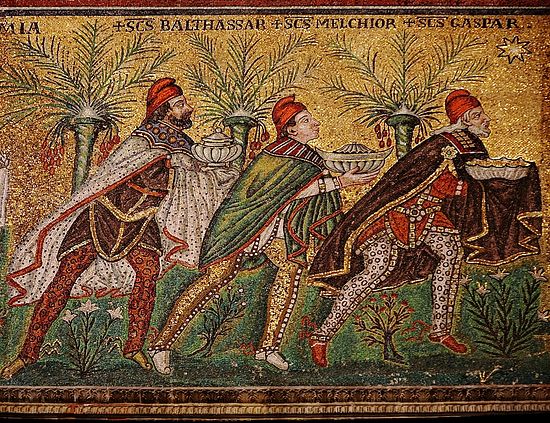 The Magi: Balthazar, Melchior and Caspar. A mosaic
The Magi: Balthazar, Melchior and Caspar. A mosaic
The Bible is silent about the number of the Magi who came to worship Jesus, but it is considered that there were three of them—according to the number of the Gifts. Their names—Balthazar, Melchior and Caspar—are first mentioned by Venerable Bede of Jarrow (+735). Some narratives have information on their appearance: Caspar is described as “a beardless youth”, Balthazar—as “a bearded elder”, and Melchior—as “swarthy”, or “black”, a native of Ethiopia.
And when they [the Magi] were come into the house, they… fell down, and worshipped Him: and when they had opened their treasures, they presented unto Him gifts; gold, and frankincense and myrrh (Mt. 2:11).The Gifts had symbolic meanings. Gold was brought to Christ as to the King of Judaea; frankincense was given to Him as to God; and myrrh, an expensive aromatic substance used for embalming of dead bodies—as to the Savior Who became the Son of Man and Whose suffering and burial had been foretold.
Having bowed before the Infant Christ, And being warned of God in a dream that they should not return to Herod (Mt. 2:12), the Magi returned to their own land, bypassing Jerusalem.
Tradition has it that afterwards all of them became Christians and preachers of the Gospel. They were baptized by holy Apostle Thomas who spread the Good News in Parthia and India. According to Western tradition, St. Thomas even consecrated them as bishops. The relics of the Magi were uncovered by holy Equal-to-the-Apostles Empress Helena in Persia and taken to Constantinople, and later to Milan in the sixth century. Today the gilded shrine with their relics is preserved at Köln Cathedral in Germany.1
The Theotokos kept the Holy Gifts all Her life. Shortly before Her Dormition She handed them over to the Church of Jerusalem where, together with Her Cincture and Robe, they were kept until 400 A.D. Then the Byzantine Emperor Arcadius (Arkadios) translated them to Constantinople where they were later placed at the Church of Hagia Sophia.
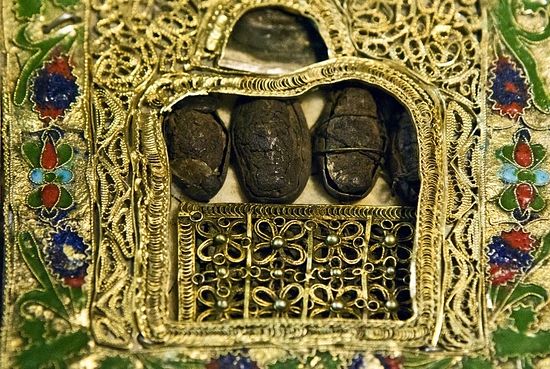 The Gifts of the Magi. Photo by Igor Belokopytov
The Gifts of the Magi. Photo by Igor Belokopytov
So what are the Gifts of the Magi like?
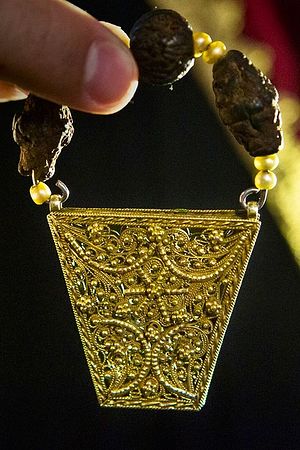 The Gifts of the Magi. Photo by Igor Belokopytov The gold brought by the Magi is in the form of twenty-eight small pendants with various shapes (trapezoidal, rectangular, and polygonal), adorned with a fine filigree ornament. Each pendant has a different design. The frankincense and myrrh, although brought separately, were subsequently joined into small, dark, olive-sized beads. There are around seventy of them left. This joining is highly symbolic—frankincense and myrrh that were brought to God and Man are united as inseparably as the two natures (the Divine and the human) are united in Christ.
The Gifts of the Magi. Photo by Igor Belokopytov The gold brought by the Magi is in the form of twenty-eight small pendants with various shapes (trapezoidal, rectangular, and polygonal), adorned with a fine filigree ornament. Each pendant has a different design. The frankincense and myrrh, although brought separately, were subsequently joined into small, dark, olive-sized beads. There are around seventy of them left. This joining is highly symbolic—frankincense and myrrh that were brought to God and Man are united as inseparably as the two natures (the Divine and the human) are united in Christ.
In 1453, Sultan Mehmed (Mohammed) II besieged and captured Constantinople, and the Byzantine Empire fell. The young sultan’s mother was Mara (Maria) Brankovic, a Serbian princess. During the Ottoman captivity European monarchs often strove to become related to the Sublime Porte to make their lives if only a little easier. Thus Mara, daughter of the Serbian Despot George Brankovic, became the wife of Sultan Murad II (1404—1451). Mara refused to embrace Islam and remained Orthodox for the rest of her life. It’s inconceivable what Mara felt when she saw the walls of the great Christian city being destroyed and her brothers and sisters in Christ being killed in torments! But that personal tragedy of a Serbian princess turned out to be true happiness for the history of Christendom. Thanks to her, many Orthodox relics were saved and survived. Mehmed II, who loved his mother dearly and respected her religious feelings, did not interfere with this.
In addition to collecting holy relics, the Sultan allowed his mother to take Holy Mount Athos under her personal protection, since all the previous rulers of Constantinople considered it an honor to help the monastic state. The Sultanas of subsequent centuries liked the tradition established by Mara Brankovic so much that, even as Muslims, they earnestly cherished this stronghold of Orthodoxy right up to the fall of the Porte.
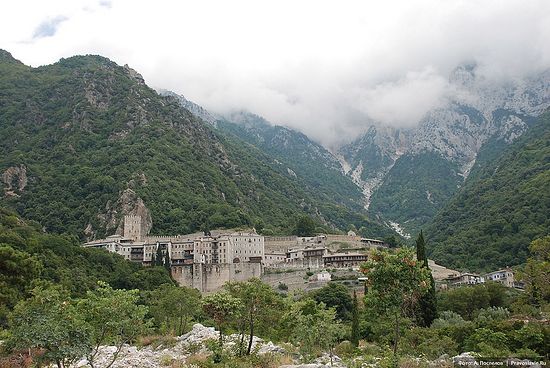 St. Paul’s Monastery on Mt. Athos. Photo by A. Pospelov / Pravoslavie.ru
St. Paul’s Monastery on Mt. Athos. Photo by A. Pospelov / Pravoslavie.ru
In 1470, Mara Brankovic decided to visit Mt. Athos, which she had loved so much since childhood and whose land she had dreamed of visiting, despite the thousand-year-old monastic tradition that forbade women to come to the Holy Mountain. Most of all she wanted to see the monastery of St. Paul of Xeropotamou, in which many Serbs struggled at that time. It was her father’s (George Brankovic’s) beloved monastery. He had built there the church of St. George the Victorious, his patron-saint.
Mara’s ship pulled in to the shore near St. Paul’s Monastery. Mara had brought ten reliquaries with the saved relics, with the Gifts of the Magi among them. At the head of a solemn procession Mara began to climb the mountain. Halfway to the monastery she stopped in amazement after hearing a voice:
“Don’t come close! From here begins the kingdom of another Sovereign—the Queen of Heaven, Lady Theotokos, the Guardian and Protectress of the Holy Mountain!” Mara fell to her knees and began to pray, asking for forgiveness of the Theotokos for her willfulness. The abbot and the brethren came out of the monastery to meet Mara, who handed the reliquaries with relics to them. After that Mara walked back and boarded the ship.
A cross was erected on the spot where Mara once stood kneeling, and it was called “the Cross of the Queen.” The chapel standing next to it depicts the meeting of these great relics.
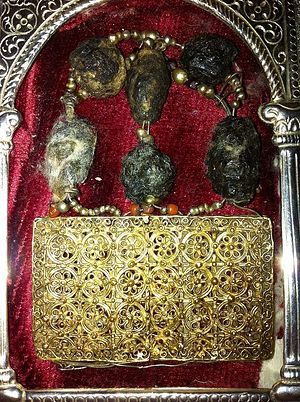 The Gifts of the Magi. Photo by Igor Belokopytov And the precious Gifts are preserved with reverence at St. Paul’s Monastery to this day. The monks are well aware of how great are relics’ spiritual and historical value, so after the night service they bring the Gifts out of the sacristy in a small silver casket for pilgrims to venerate. The Gifts give off a strong fragrance, and when they are opened the whole church is filled with a fragrance. Athonite monks noticed that the Gifts heal the mentally ill and the demonically possessed. Some pilgrims say that when the monks brought one of the golden pendants to their ear, a sort of whisper was miraculously heard from it, telling of the miraculous Birth of the Eternal Child into the world…
The Gifts of the Magi. Photo by Igor Belokopytov And the precious Gifts are preserved with reverence at St. Paul’s Monastery to this day. The monks are well aware of how great are relics’ spiritual and historical value, so after the night service they bring the Gifts out of the sacristy in a small silver casket for pilgrims to venerate. The Gifts give off a strong fragrance, and when they are opened the whole church is filled with a fragrance. Athonite monks noticed that the Gifts heal the mentally ill and the demonically possessed. Some pilgrims say that when the monks brought one of the golden pendants to their ear, a sort of whisper was miraculously heard from it, telling of the miraculous Birth of the Eternal Child into the world…

